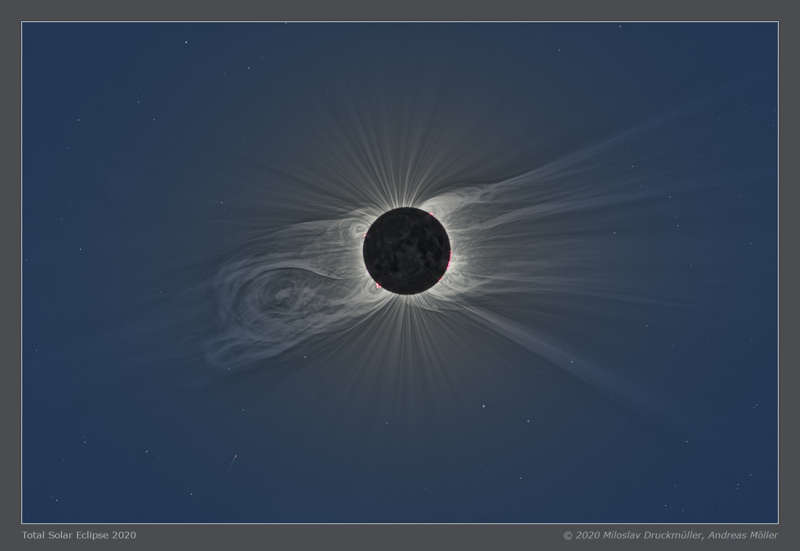Credit & Copyright: Miloslav Druckmuller,
Andreas Moller,
(Brno University of Technology),
Explanation:
Along a narrow path
crossing southern South America through Chile
and Argentina, the final New Moon of 2020
moved in front of the Sun on December 14 in the year's only
total solar eclipse.
Within about 2 days of perigee, the closest point in its elliptical
orbit, the New Moon's surface is faintly
lit by earthshine
in this dramatic composite view.
The
image is a processed composite
of 55 calibrated exposures ranging from 1/640 to 3 seconds.
Covering a large range in brightness during totality,
it reveals the dim lunar surface and faint background stars,
along with
planet-sized
prominences at the Sun's edge, an enormous
coronal mass ejection,
and sweeping coronal structures normally hidden in the Sun's glare.
Look
closely
for an ill-fated sungrazing Kreutz family comet
(C/2020 X3 SOHO)
approaching from the lower left, at about the 7 o'clock position.
In 2021 eclipse chasers will see an annular solar eclipse coming up
on June 10.
They'll have to wait until December 4 for the only total
solar eclipse in 2021 though.
That eclipse
will be
total along a narrow path crossing the southernmost
continent of Antarctica.
1999 2000 2001 2002 2003 2004 2005 2006 2007 2008 2009 2010 2011 2012 2013 2014 2015 2016 2017 2018 2019 2020 2021 2022 2023 2024 2025 |
Yanvar' Fevral' Mart Aprel' Mai Iyun' Iyul' Avgust Sentyabr' Oktyabr' Noyabr' Dekabr' |
NASA Web Site Statements, Warnings, and Disclaimers
NASA Official: Jay Norris. Specific rights apply.
A service of: LHEA at NASA / GSFC
& Michigan Tech. U.
|
Publikacii s klyuchevymi slovami:
total solar eclipse - polnoe solnechnoe zatmenie
Publikacii so slovami: total solar eclipse - polnoe solnechnoe zatmenie | |
Sm. takzhe:
Vse publikacii na tu zhe temu >> | |
